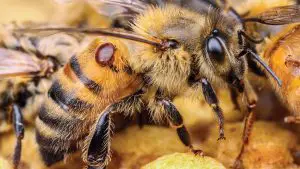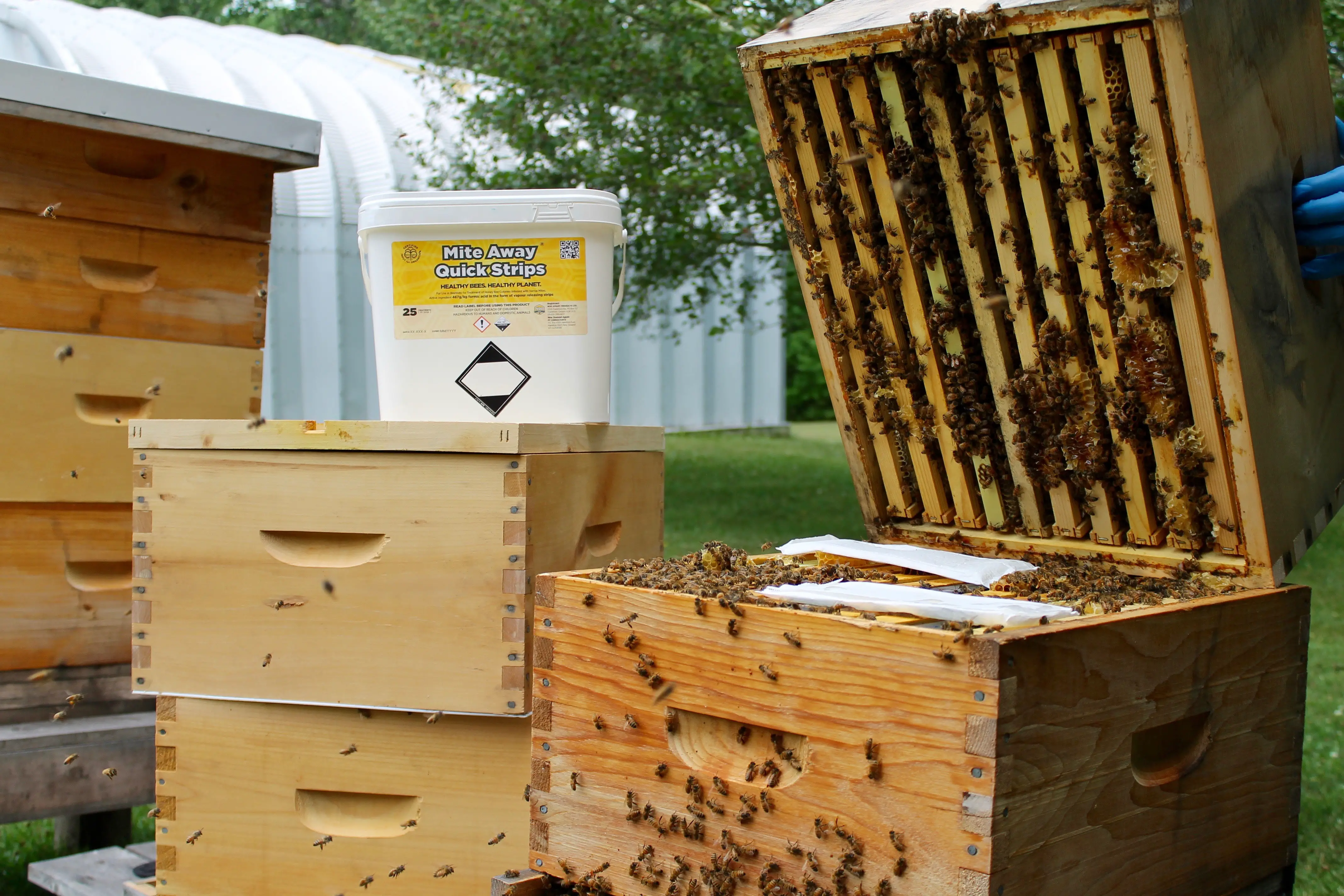Bees play a crucial role in our ecosystems. They pollinate flowers, crops and trees, which then serve as food and even shelter for other creatures. Sadly, they face several threats, the greatest of which is the varroa mite.
These are external parasites, which thrive by sucking hemolymph from adult bees and their developing broods. The hemolymph is equivalent to blood in other living organisms, although in this case, it’s a mixture of blood and lymphatic fluid.
One of the best treatments for varroa infestations is the MiteAway Quick Strips (MAQS). In this article, we’ll explain how to get the most out of this miticide and what you can do to avoid its side effects.
A Primer on Varroa Mites
Also known as the Varroa destructor, these are highly-destructive parasites that are about the size of a pinhead. They attach themselves on bees and then suck out their internal fluids.
When this happens, the bees become disoriented and incapacitated to fend for themselves. This can lead to Colony Collapse Disorder (CCD)- a phenomenon that occurs when the worker bees abscond, leaving the queen and her babies to perish.
When the varroa mites attack maturing brood, the bees that emerge may suffer deformations such as missing wings and legs.
It’s vital that you inspect your hives regularly to identify mite infestations when it’s still early. An adult female mite will have eight legs and a red-brown, flattened body that extends to about 1 or 1.5mm in width. The good thing is that this parasite is big enough to be seen by the naked eye.

An infestation of varroa destructor can wipe out your colony, and subsequently, put you out of the beekeeping business. This is because the mites spread easily from one colony to another.
Since they attach on the bees’ bodies, they can be spread through worker bees to other areas. Bees can also get infested when they’re robbing smaller colonies.
To mitigate the risk of spreading, you should always isolate package bees, captured swarms and any new colonies you bring home. This way, it will be easy to inspect them for mites before introducing them to the apiary.
How Do MiteAway Quick Strips Work?
The first point to note here is that the MAQS strips should be used in conjunction with an integrated pest management program. This way, you’re guaranteed of getting rid of the mites and preventing future infestations.
To get started, first ensure that the bees have sufficient access to fresh air. The manufacturer recommends creating an entrance that is at least the size of the hive’s width. MAQS contain formic acid, which is one of the natural components of honey, which is one of the reasons it’s able to destroy mites without harming the bees, but formic acid releases formic vapours which can be toxic in high concentrations.
The most convenient position to set up this entryway is on the bottom board, and it should be kept completely open during the course of the treatment. The MAQS strips are usually administered over a period of 7 days.
Once you’re certain that there’s proper airflow, place the strips in either a single or double-chambered Langstroth hive. You only need to put 1 sachet, which contains 2 strips, in each hive. Here is a guide to help you:
Single brood chamber
If you’re dealing with a single chamber, place the two strips on the frame top bars of chamber. The strips should be lying flat and across the width of the hive. Put the strips so that they’re about 5 cm apart and at least 10cm from the ends of the brood chamber.
Two brood chamber
With this unit, you’ll need to put the strips on the frame top bars of the lower hive section. This way, the strips will be lying between the two brood chambers.

Do MiteAway Quick Strips Cause Side Effects?
The reason why these strips are so effective is because they contain formic acid. This compound is lethal to mites but it does not cause any harm to bees.
That said, the kind of results you get differ from one colony to another. While some colonies don’t seem to experience any side effects, there are a few that are negatively affected. Possible side effects include bearding and brood loss.
According to the manufacturer, the reason why these effects arise is because the treatment wasn’t administered properly. To prevent this, adhere to the following:
 Perform the treatment only when temperatures are favorable. Outdoor temperatures should be ranging between 10 and 29.5°C. If the temperatures are any higher, postpone the application until they drop.
Perform the treatment only when temperatures are favorable. Outdoor temperatures should be ranging between 10 and 29.5°C. If the temperatures are any higher, postpone the application until they drop.
 Ensure the colonies have adequate food reserves at the point of treatment.
Ensure the colonies have adequate food reserves at the point of treatment.
 Do not use the dosage given for hives that are smaller than what is stipulated.
Do not use the dosage given for hives that are smaller than what is stipulated.
MAQS Problems Reported
Formic Acid, the main component of MiteAway Quick Strips, can be toxic to both the applicant (the beekeeper) and the bees/brood. Underdosing the hive results in ineffective varroa control, whereas using too much can result in brood or colony death. It’s crucial you read the instructions well, and use the recommended number of strips per hive.
Formic acid releases a gas, formic vapours, which can actually erode metals within the hive, such as queen excluders, mite screens, and nails.
Mite away quick strips may also kill eggs and some of the young brood, while also stopping the queen from laying eggs for up to 10 days. If you see no evidence of egg laying after 5-10 days it would be wise to do a thorough hive inspection and check the hive still has a queen. This issue is especially prevalent during dearth periods, and when temperatures exceed 29.5°C. You may want to postpone treatment until temperatures have dropped or until nectar flow resumes.
Supers placed immediately after treatment can contain elevated levels of formic acid when it comes time to harvest (although usually not enough to the point of affecting the taste).
Should You Use MiteAway Quick Strips?
Colonies of bees all across the globe are at risk of numerous threats ranging from pesticides, to diseases and habitat loss. However, research studies have shown that the greatest challenge they face is the infestation by Varroa destructor. MiteAway Quick Strips are a convenient, affordable way to help get rid of these vermin.
While you may experience some problems when using these strips, this only happens rarely. If you follow all the instructions on the label you’ll be able to avoid most of the issues above. If possible, reach out to other Beekeepers in your area or your local beekeeping association and ask their experiences with these strips, as local factors including weather and nectar sources can influence treatment effectiveness.


![3 Big Mistakes Beginner Beekeepers Make [And How To Avoid Them!]](https://beekeepingabc.com/wp-content/uploads/2020/11/3-mistakes-beginner-beekeepers-make-90x75.jpg)

![Move over ducks, Queen Bees quack too! [Here’s Why]](https://beekeepingabc.com/wp-content/uploads/2020/06/queen-bee-90x75.png)
![The Flow Hive 2 Review [ Vs. The Classic Flow Hive]](https://beekeepingabc.com/wp-content/uploads/2020/02/Flow-Hive-2-90x75.jpg)
![How Bees Fly [10 Facts About How, When, and Why]](https://beekeepingabc.com/wp-content/uploads/2019/12/A-Bee-Flying-90x75.jpg)